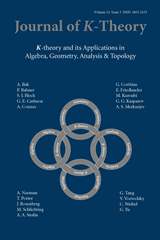Article contents
Twisted homological stability for extensions and automorphism groups of free nilpotent groups
Published online by Cambridge University Press: 30 June 2014
Abstract
We prove twisted homological stability with polynomial coefficients for automorphism groups of free nilpotent groups of any given class. These groups interpolate between two extremes for which homological stability was known before, the general linear groups over the integers and the automorphism groups of free groups. The proof presented here uses a general result that applies to arbitrary extensions of groups, and that has other applications as well.
Keywords
- Type
- Research Article
- Information
- Copyright
- Copyright © ISOPP 2014
References
REFERENCES
- 4
- Cited by




